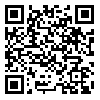Volume 59, Issue 5 (9 2001)
Tehran Univ Med J 2001, 59(5): 23-28 |
Back to browse issues page
Download citation:
BibTeX | RIS | EndNote | Medlars | ProCite | Reference Manager | RefWorks
Send citation to:



BibTeX | RIS | EndNote | Medlars | ProCite | Reference Manager | RefWorks
Send citation to:
Behdani R, Rezaei E. The frequency of urinary stress incontinence after delivery in primiparous women and the related factors. Tehran Univ Med J 2001; 59 (5) :23-28
URL: http://tumj.tums.ac.ir/article-1-1290-en.html
URL: http://tumj.tums.ac.ir/article-1-1290-en.html
Abstract: (4995 Views)
In order to determine the frequency rate of urinary stress incontinence (S.I) after delivery and related factors a longitudinal study carried on primiparous women in Arash Hospital in 1379. Through a non probability sampling, 400 eligible women were recruited from available population. Patient with complain of urinary stress incontinence on third day after delivery, were examined and undergone for required diagnostic tests. After stabilizing the diagnosis of urinary stress incontinence, they were followed on 6th week, 3th month and the first year after delivery. The mean of maternal age was 23.5±4.3 years and the mean of gestational age was 37.9±2.1 weeks. The vaginal delivery and cesarean section rates were 83.7 percent and 16.3 percent respectively. From the cases, 50 women (12.5 percent) had S.I on third day after delivery, which 28 of them had this problem from their pregnancy (grup A), and in 22 patients (5.5 percent), S.I were began after delivery (group B). On first year after delivery, only 6 patients (1.5 percent) had complaint of S.I, totally. All patients with S.I had a vaginal delivery and no cases of S.I had found in cesarean section group (65 women). This difference was significant (P=0.019). Comparison of 3 groups A, B and C (including 285 women without S.I after vaginal delivery) had represented that the mean of maternal age and gestational age were significantly higher in group B than other two groups (P=0.0001 and P=0.0009 respectively).
Keywords: Urinary stress incontinence, Primiparous
| Rights and permissions | |
 |
This work is licensed under a Creative Commons Attribution-NonCommercial 4.0 International License. |





